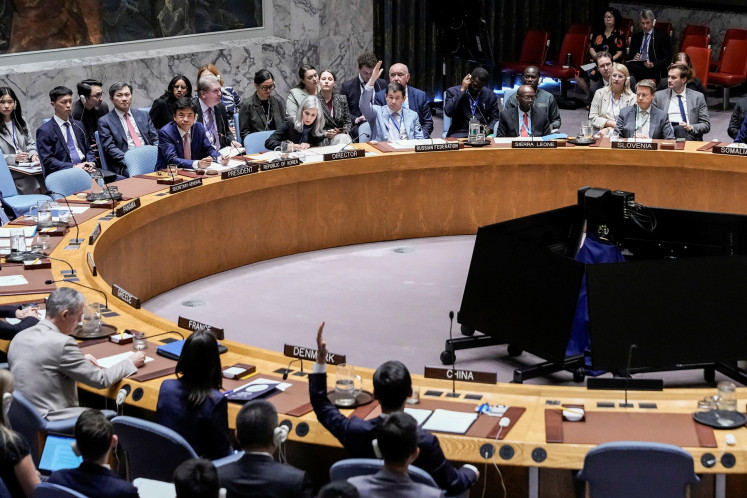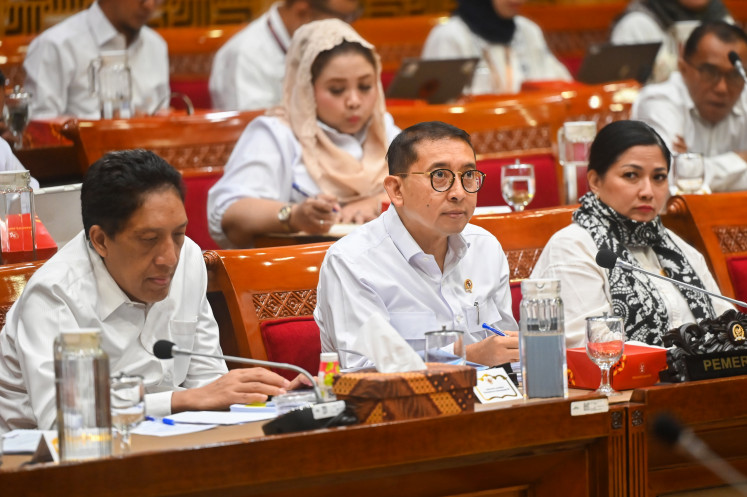Popular Reads
Top Results
Can't find what you're looking for?
View all search resultsPopular Reads
Top Results
Can't find what you're looking for?
View all search resultsAnalysis: Encouraging the receipt of Indonesian remittances
In Indonesia’s balance of payments in the first quarter, the current account deficit (CAD) was recorded at US$7 billion (2
Change text size
Gift Premium Articles
to Anyone
I
n Indonesia’s balance of payments in the first quarter, the current account deficit (CAD) was recorded at US$7 billion (2.6 percent of GDP), lower than the previous quarter’s deficit of $9.2 billion (3.6 percent of GDP). The CAD improvement was mostly driven by an increase in the goods trade balance ($1 billion surplus compared to $2.6 billion deficit in the fourth quarter of 2018) as a result of a increase in the non-oil and gas trade balance surplus ($2.5 billion compared to $100 million) and improvement in the oil and gas trade balance deficit ($2 billion deficit vs. $2.9 billion deficit).
Another component in the current account that recorded a surplus was secondary income ($1.9 billion). In its revenue component, which reached $2.9 billion, the contribution of personal transfers made by Indonesian migrant workers through domestic remittances reached 93 percent ($2.7 billion). Historically, this was the highest quarterly remittance compared to the same quarter in previous years. According to Bank Indonesia (BI), the highest contribution of remittances in Q1 2019 came from the Asia Pacific region (61 percent), followed by the Middle East and Africa (31 percent).
The above data show that the receipt of remittances plays an important role in supporting Indonesia’s current account performance. If we could increase the receipt of remittances, the performance of the current account would be better in the midst of various pressures related to trade wars between other countries. In 2018, the receipt of remittances amounted to $11 billion, only equivalent to 70 percent of what Vietnam received ($15.9 billion) and only one-third of what the Philippines received ($33.8 billion). If remittance revenue could be increased to that of Vietnam, the CAD ratio to GDP in 2018 would decrease to 2.51 percent from the actual 2.98 percent. And if it could reach the Philippine level, the ratio would decrease to 0.79 percent. Remittances therefore have much potential and pose a challenge that needs to be resolved by various parties.
Increasing remittances would not only increase the amount of money coming into the country but would also be an important step in supporting financial inclusion. Transferring funds through the formal system has the potential to direct the unbanked and potential senders or recipients to use formal financial products and services in the future. By entering into formal financial services, track records of the unbanked could be monitored and analyzed for various financial service policies and strategies. In addition, money transfers could increase demand for savings and thereby increase domestic liquidity.
To increase the potential for remittance receipts, several things need to be resolved. The first thing is related to how much remittance potential Indonesia has and how remittances are conducted. In addition to knowing the potential, this step is also important in understanding the behavior of migrant workers in sending money to Indonesia.
By Q1 2019, the number of Indonesian migrant workers working abroad reached 3.7 million (BI). Vietnamese migrant workers numbered about 540,000, or only about one-seventh of Indonesian migrant workers (International Labor Organization). Meanwhile, up to 2018, Philippine migrant workers reached 2.3 million workers (Philippine Statistics Authority). Nearly a quarter of them work in basic services, such as domestic workers and caregivers, and one-fifth work as plant and machine operators. Those who work in the service sector and sales reached 16 percent, while technicians and professionals amounted to 11 percent each.
The situation is quite different in Indonesia, where domestic workers and caregivers account for half of the migrant workers. Next are plantation workers (10 percent) and those who work as operators (8 percent). Vietnamese migrant workers generally work in manufacturing, construction and the fishing industry. The difference in types of work results in differences in income received, which would have an impact on the value of remittance receipts.
Regarding remittance delivery, it is common for Indonesian migrant workers to ask peers to carry the money into the country for them. As a result, the amount of money sent is not recorded in the formal system, so remittance data is not entirely accurate.
This informal way is practiced because of, among other things, the cost of sending money through formal channels, such as a bank or money transfer agent, is considered quite high. According to the World Bank, the average cost of sending $200 to low- and middle-income countries in Q1 of this year reached 7 percent, about twice the target in the Sustainable Development Goals in 2030, which is 3 percent. The average cost for East Asia and the Pacific region is quite high (7.2 percent), followed by the Middle East and North Africa (6.8 percent), Europe and Central Asia (6.7 percent), Latin America and the Caribbean (6.2 percent), and South Asia (5 percent). The highest costs are in Sub-Saharan Africa (9.3 percent).
By method, the highest remittance cost is through banks (10.9 percent), while through a post office is lower (7.6 percent). Besides costs, one significant obstacle for migrant workers in transferring remittances through banks is a relatively higher exchange rate than that of other retail channels. Therefore, banks are more suitable for migrant workers whose income is quite high, whereas the number of such workers is limited. However, to facilitate remittances, Indonesian banks could support it through the establishment of a money transfer company.
Another thing that needs to be done is prepare Indonesian migrant workers to work in occupations that offer higher incomes than they currently earn. To work as a professional, the availability of licenses and certification remains an obstacle. For example, every year Indonesia produces 50 thousand nurses, but only 20 to 30 thousand nurses are absorbed domestically.
On the other hand, there is a huge opportunity regarding the surplus of nurses. For example the United States will require about 1 million nurses up to 2030. The Philippines and Vietnam have been more proactive in availing of this opportunity. When the US changes anything in its nursing curriculum, the Philippines also adjusts its curriculum. Meanwhile, Vietnam follows a German nursing curriculum. Reflecting on the aforementioned, our education must be flexible enough to follow the needs of the industry. This means that the link-and-match program for the industry must be improved.
______________
The writer is a researcher at Mandiri Institute










